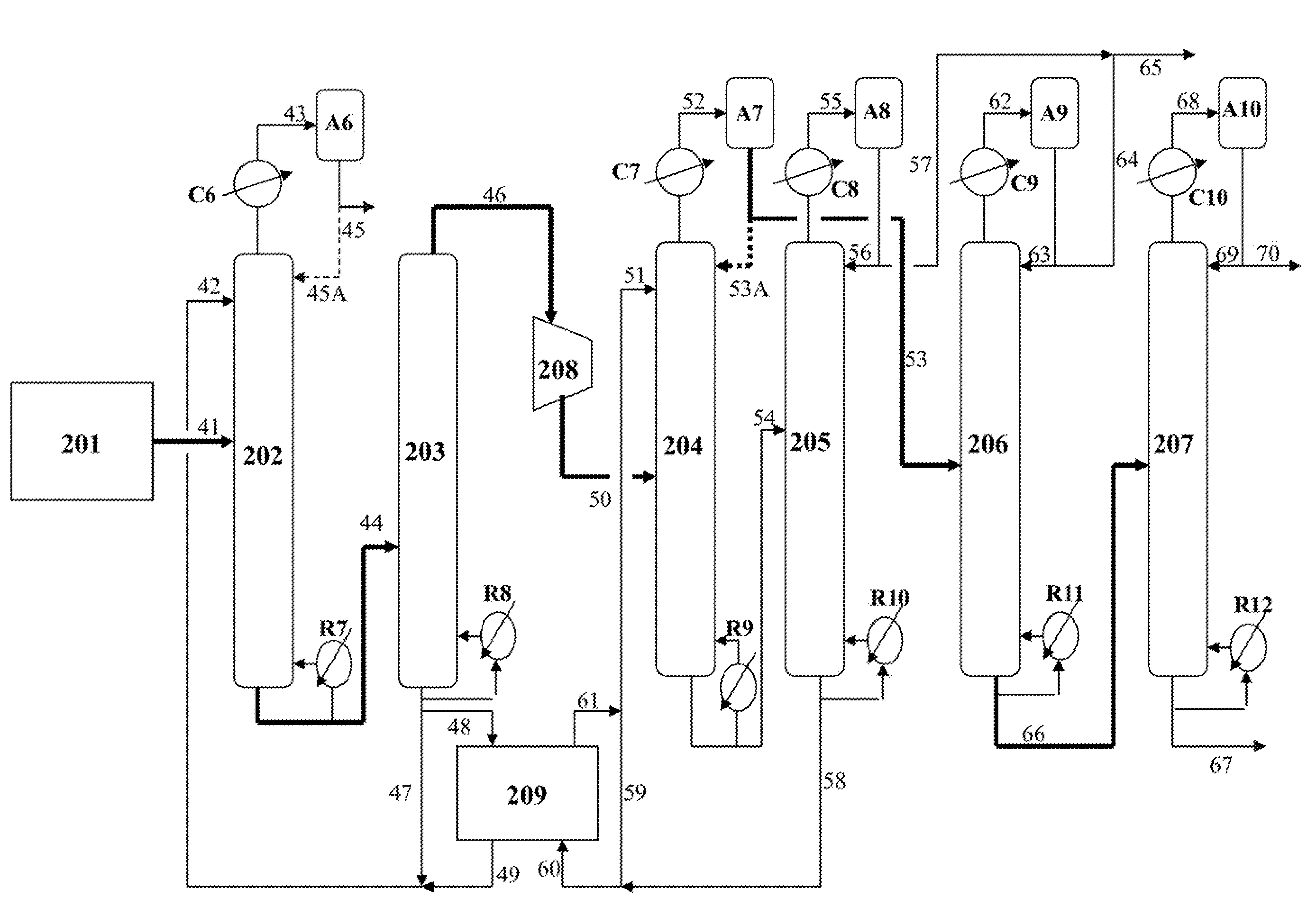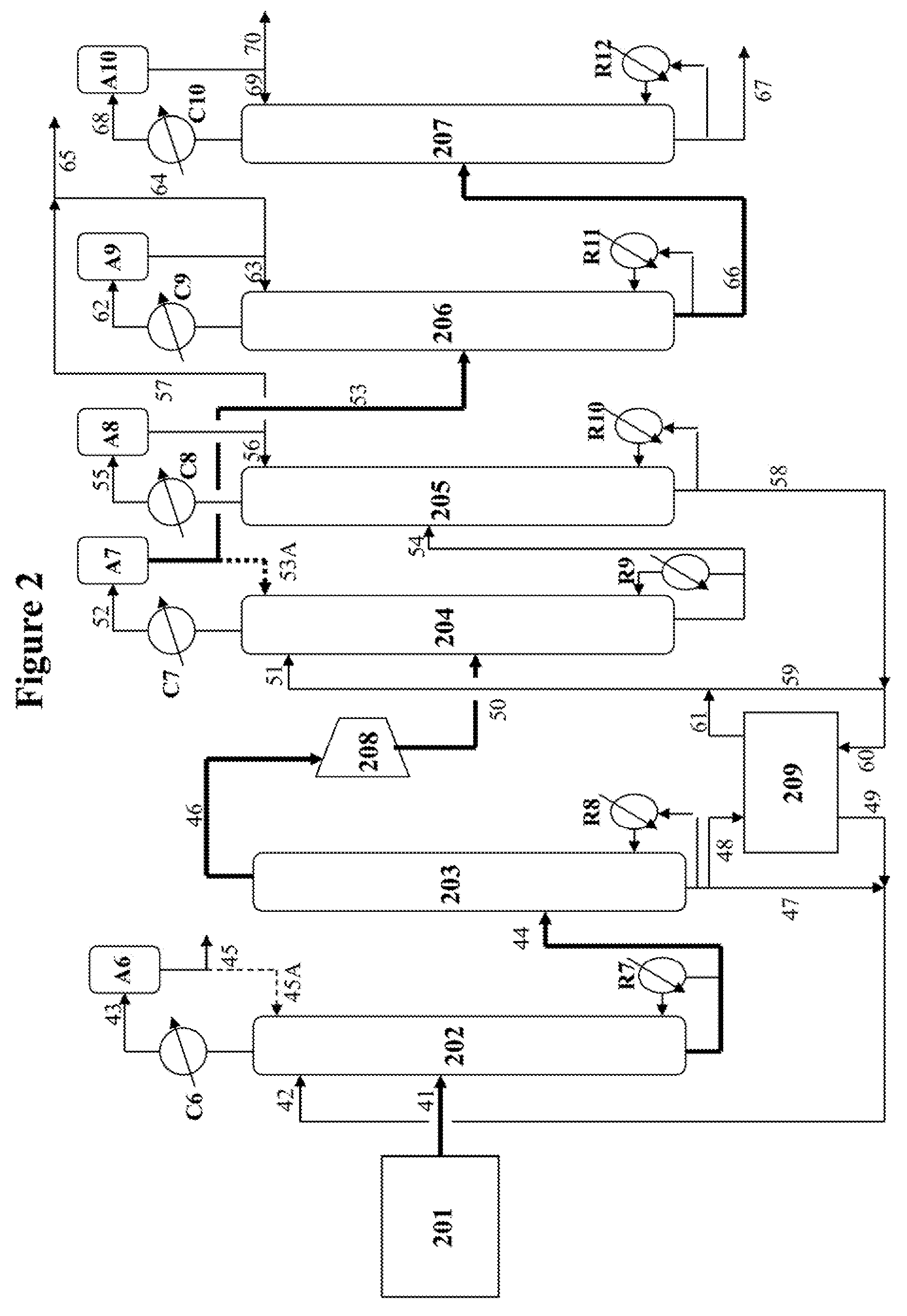Extractive distillation process for recovering butadiene from C4 hydrocarbon mixtures
a technology of c4 hydrocarbon mixture and distillation process, which is applied in the direction of separation process, organic chemistry, chemistry apparatus and process, etc., can solve the problems of large capital and energy consumption of the overall process, small differences in relative volatilities of the components, and the inability of distillation to separate 1,3 butadiene, etc., to achieve the effect of enhancing throughput and reducing utilities and energy consumption
- Summary
- Abstract
- Description
- Claims
- Application Information
AI Technical Summary
Benefits of technology
Problems solved by technology
Method used
Image
Examples
example 1
Comparative—Base Case
[0057]In this base case representing the ED process as illustrated in FIG. 1, the first EDC is operated under a reflux-to-distillate weight ratio (R / D) of 1.8 and the second EDC is operated under an R / D of 1.1. The solvent-to-hydrocarbon weight ratio (S / F) for the first EDC is 5.7 and for the second EDC is 1.7. This base case yields a purified butadiene product containing 99.85 wt % 1,3 butadiene with 98.5 wt % recovery, operated under a throughput of 58,000 to 59,000 Kg / Hr of C4 hydrocarbon feed containing approximately 45 wt % 1,3 butadiene.
[0058]Referring to FIG. 1, from the feed tank 101, 58,800 Kg / Hr of a C4 hydrocarbon fraction containing butadienes is fed continuously to the middle portion of the first EDC 102 at 49° C. and 4.6 Kg / cm2 (pressure) via line 1. This stream contains approximately 46 wt % 1,3 butadiene, 14 wt % 1-butane, 24 wt % isobutene, 10 wt % 2-butenes, 5 wt % butanes, and 1 wt % acetylenes (mostly vinylacetylene). 336,000 Kg / Hr of DMF sol...
example 2
Significant Reduced Reflux at the First and Second EDCs
[0065]This example demonstrates that the performances of the first and second EDCs are not affected by substantially reducing the column overhead reflux and the energy consumption of these two EDCs is significantly decreased as a result of the diminished reflux.
[0066]Referring to FIG. 2, the same C4 hydrocarbon fraction containing approximately 46 wt % butadiene is fed continuously to the middle portion of the first EDC 202 at the same flow rate via line 41, under the same temperature and pressure as those of the base case in Example 1. The same DMF solvent containing 96 wt % DMF and 4 wt % squalane (tar) is introduced to the upper portion of the first EDC 202 via line 42, under the same temperature and pressure as the base case. The overhead vapor in line 43 is then condensed by cooler C6 and collected in the accumulator A6 where only a very minor portion of the condensate is recycled to the top of column 202 as reflux at a ref...
example 3
The Optimum Reflux at the First EDC
[0073]Examples 1 and 2 demonstrate that the first EDC consumes three times the energy as the second EDC. This example shows a method of determining an optimal reflux to generate the maximum energy savings in the first EDC without affecting its performance. Table 3 summarizes the key stream compositions of the first EDC for the base case as well as for two other cases operating under different reflux ratios. Table 3 also compares the energy requirements of the first EDC under different reflux ratios.
[0074]
TABLE 3Key Stream Composition and Energy Consumptionof the First EDC under Various Reflux RatiosReflux Ratio1.8 (Base Case)0.09 (5%)0.00 (No Reflux)Stream No.4142444544454445Butanes4.7009.209.209.21-Butene14.40027.9027.9027.9i-Butene23.50045.7045.7045.72-Butenes10.000.2 16.90.217.00.216.71,3 Butadiene45.908.40.28.40.18.501,2 Butadiene0.400.100.100.10Methylacetylene 200 ppm0 37 ppm1 ppm 38 ppm0 38 ppm0Ethylacetylene1900 ppm0 581 ppm0 547 ppm0 547 pp...
PUM
| Property | Measurement | Unit |
|---|---|---|
| Fraction | aaaaa | aaaaa |
| Fraction | aaaaa | aaaaa |
| Fraction | aaaaa | aaaaa |
Abstract
Description
Claims
Application Information
 Login to View More
Login to View More - R&D
- Intellectual Property
- Life Sciences
- Materials
- Tech Scout
- Unparalleled Data Quality
- Higher Quality Content
- 60% Fewer Hallucinations
Browse by: Latest US Patents, China's latest patents, Technical Efficacy Thesaurus, Application Domain, Technology Topic, Popular Technical Reports.
© 2025 PatSnap. All rights reserved.Legal|Privacy policy|Modern Slavery Act Transparency Statement|Sitemap|About US| Contact US: help@patsnap.com



